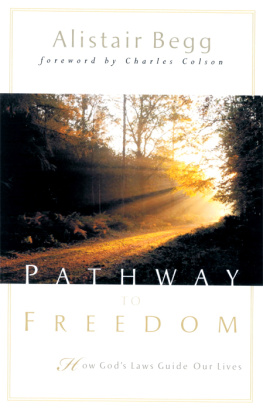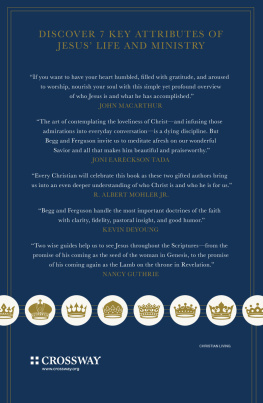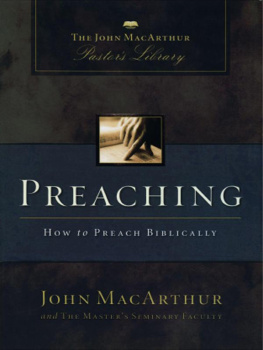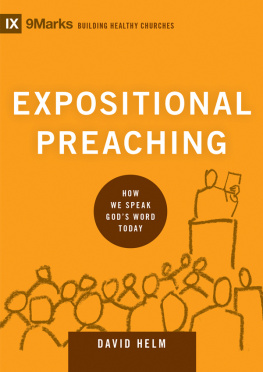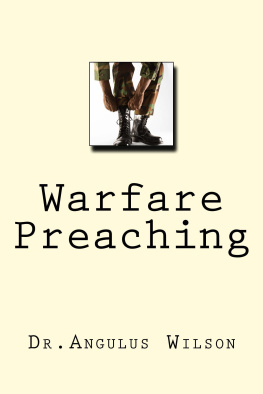Preaching for Gods Glory


I have a vivid recollection as a small boy of sitting in St. Georges Tron Church in Glasgow waiting for the commencement of morning worship. At about three minutes to 11 the beadle (parish official) would climb the pulpit stairs and place a large Bible on the lectern. Having opened it to the appropriate passage, he would descend, and the minister would in turn ascend the stairs and sit in the cone-shaped pulpit. The beadle would complete his responsibilities by climbing the stairs a second time to close the pulpit door and leave the pastor to his task. There was no doubt in my young mind that each part of that procedure was marked with significance. There was clearly no reason for the pastor to be in the pulpit apart from the Bible upon which he looked down as he read. I understood that, in contrast to his physical posture, the preacher was standing under Scripture, not over it. Similarly, we were listening not so much for his message but for its message. We were discovering, as J. I. Packer has suggested, that preaching is letting texts talk. The right preaching of the Word of God is powerful!
Although D. Martyn Lloyd-Jones voiced his concerns about a certain literary style of Scottish preaching, he would not have disputed the following observation by James W. Alexander: Among the Scottish Presbyterians every man and every woman, nay, almost every child, carried his pocket-Bible to church, and not only looked out the text, but verified each citation; and as the preaching was in great part of the expository kind, the necessary consequence was, that the whole population became intimately acquainted with the structure of every book in the Bible, and were able to recall every passage with its appropriate accompanying truths (Thoughts on Preaching [Edinburgh and Carlisle, Pa.: Banner of Truth, reprint 1975], p. 240).
Long ago the godly Richard Baxter reminded his fellow pastors of the central place of preaching in the fulfillment of their duties:
We must be serious, earnest, and zealous in every part of our work. Our work requireth greater skill, and especially greater life and zeal, than any of us bring to it. It is no small matter to stand up in the face of the congregation, and to deliver a message of salvation or damnation, as from the living God, in the name of the Redeemer. It is no easy matter to speak so plain, that the most ignorant may understand us; and so seriously that the deadest heart may feel us; and so convincingly, that the contradicting cavillers may be silenced. (The Reformed Pastor [Edinburgh and Carlisle, Pa.: Banner of Truth, reprint 1974], p. 117)
IN THE SHADOWS
Unfortunately, Baxters challenge seems to be beyond the skill and will of most contemporary preachers with the result that true expository preaching has fallen on hard times. About fifty years ago W. E. Sangster, a great Methodist preacher in Britain, began a volume on preaching with the words, Preaching is in the shadows. The world does not believe in it (The Craft of the Sermon [Harrisburg, Pa.: Epworth Press, 1954], p. 1). Today, at the beginning of a new millennium, the situation is graver still. Preaching is still in the shadows, but this time much of the church does not believe init.
Much of what now emanates from contemporary pulpits would not have been recognized by either Alexander or Baxter or Sangster as being anywhere close to the kind of expository preaching that is Bible-based, Christ-focused, and life-changingthe kind of preaching that is marked by doctrinal clarity, a sense of gravity, and convincing argument. We have instead become far too familiar with preaching that pays scant attention to the Bible, is self-focused, and consequently is capable of only the most superficial impact upon the lives of listeners. Worse still, large sections of the church are oblivious to the fact that they are being administered a placebo rather than the medicine they need. They are satisfied with the feeling that it has done them some good, a feeling that disguises the seriousness of the situation. In the absence of bread the population grows accustomed to cake! Pulpits are for preachers. We build stages for performers.
Some years ago I enjoyed the privilege of speaking at a convention in Hong Kong. The meetings were held in an Anglican church that had a pulpit we did not use. The organizers felt it would be best if we were not six feet above the congregation but on the same level as the people. So they provided a lectern to hold the preachers Bible as he spoke. I was sharing the event with a kindly older man whom I had never met prior to the convention. We both spoke each morning. Some mornings I would preach first, sometimes he would. Whenever he began a message, his first action was to pick up the small lectern and move it off to the side where it could neither impede his movement nor create the impression that he was preaching to the people. Instead, he said, he was delivering a talk, and he wanted to be sure the listeners could relax and benefit from his conversational style. When it came time for me to preach, my first action was to put the lectern back in its place, central to the occasion. The congregation laughed as this pattern repeated itself over the course of five days. I would use it; my colleague would remove it.
Before the week was out, two incidents occurred that may or may not have been related. First, I explained to the congregation that the reason I replaced the lectern each time was not simply so I might have a place for my Bible, but because I did not want to forgo the symbolism of having a central pulpit with the Word in its deserved primary place. After all, I observed, if the preacher were to fall down or disappear, the congregation would still be left with its focus in the right placenamely, the Scriptures. I know that my preaching partner did not take this as a personal rebuke, which is what made the second incident all the more telling.
A day or two later he confided to me that he felt he had lost any real sense of passion or power in the delivery of his messages. It was very humbling for me as a young man to sit and listen as he poured out his heart and with tears reflected upon his diminished zeal. It is far too simplistic to suggest that his removal of the podium each time he spoke was a symbol of a faltering conviction regarding the priority and power of Scripture. But at the same time I have a suspicion that its removal was more than simply a matter of style or personal preference.
The layout of many contemporary church buildings, including my own, at least flirts with the danger of creating the impression that we have come to hear from man rather than to meet with God. It is imperative that we acknowledge and remember, and help each other acknowledge and remember, that we gather together as the church not to enjoy preaching eloquence (or to criticize its lack) but to hear and heed the Word of God. We come to be exhorted, not entertained.
CARICATURES OF TRUE PREACHING
If churches or their pastors begin to think of the place from which messages are delivered to the congregation as a stage, it is inevitable that caricatures of the preacher will emerge to take the true preachers place. Sadly, this is precisely what has happened. In our day the expositor of Scripture has been eclipsed by a variety of sad substitutions. We will consider a few.


